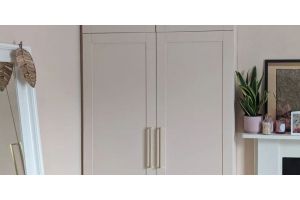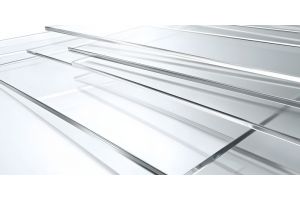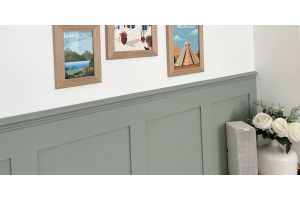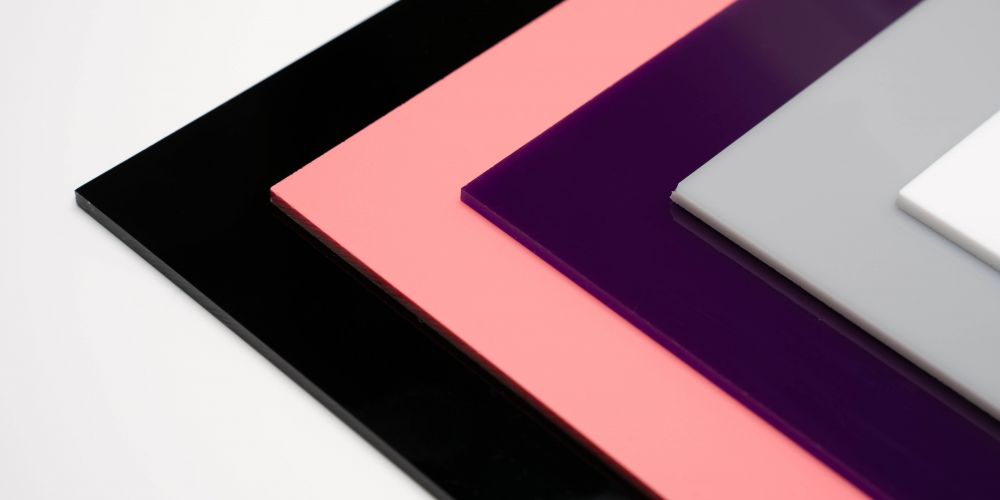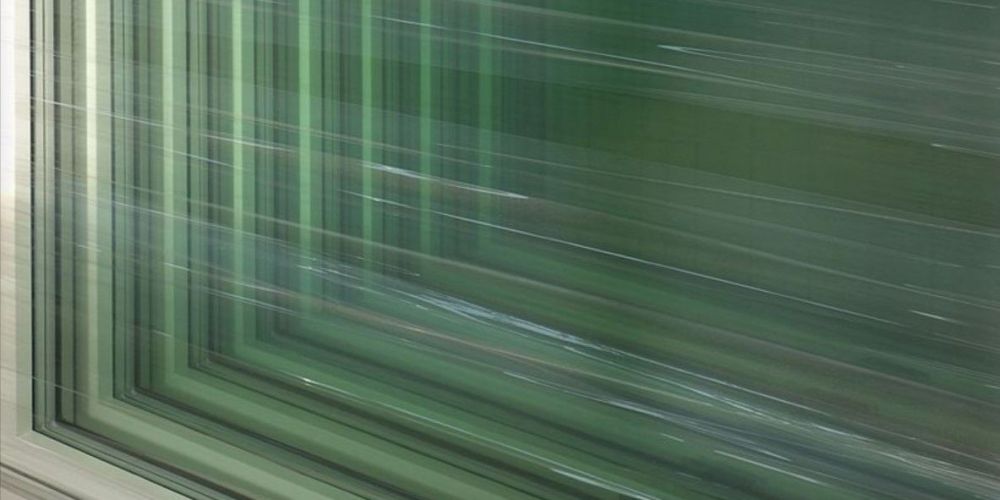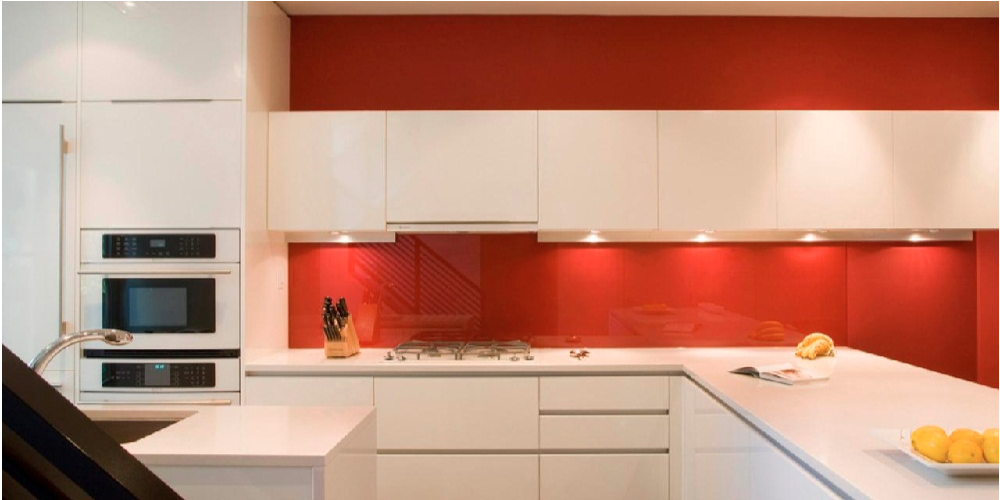When not working with the digital team at Cut My, Chloe is a Professional Organiser with over 5 years experience transforming homes across Sussex. She shares her passion for storage and organisation on the Cut My Blog.
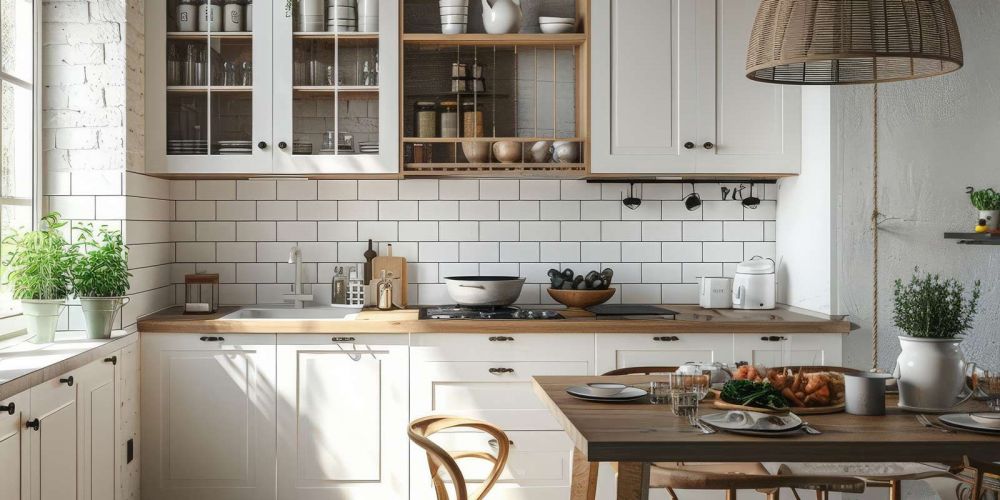
Creating the perfect kitchen involves balancing functionality with style. One critical element that serves both purposes is the kitchen splashback. This guide will walk you through a variety of splashback ideas for kitchens, focusing on materials, styles, and installation tips to help you achieve the best results. Whether you're considering a glass splashback, tile splashback, or something more unique, we've got you covered.
Understanding Kitchen Splashbacks
Definition and Purpose
A kitchen splashback is a protective panel installed on the kitchen walls behind the cooker, hob, sink, and other cooking areas. Its primary purpose is to shield the walls from splashes, stains, and extreme temperatures. Beyond practicality, splashbacks are a significant design element, offering opportunities to add colour, texture, and style to your kitchen.
Importance of Choosing the Right Splashback
Selecting the right splashback is crucial for both aesthetic and functional reasons. The ideal splashback will complement your kitchen design, withstand heat and moisture, and be easy to clean. With various materials and styles available, you can find a splashback that perfectly matches your needs and preferences.
Popular Kitchen Splashback Ideas
Tile Splashbacks
Traditional Choice: Porcelain Tiles
Porcelain tiles are a traditional choice for kitchen splashbacks. They are durable, resistant to heat and stains, and come in various colours and patterns. Porcelain tiles are also easy to clean, making them a practical option for busy kitchens.
Patterned Tiles for a Bold Statement
Patterned tiles can make a striking statement in your kitchen. Whether you choose intricate designs or bold geometric patterns, these tiles add a unique touch to your kitchen walls, creating a focal point that draws the eye.
Metro Tiles for a Classic Yet Contemporary Look
Metro tiles, also known as subway tiles, offer a timeless appeal. Their clean lines and glossy finish suit both traditional and modern kitchens. Available in various colours, metro tiles can be arranged in different patterns, such as herringbone or brick, to add a contemporary look to your kitchen splashback.
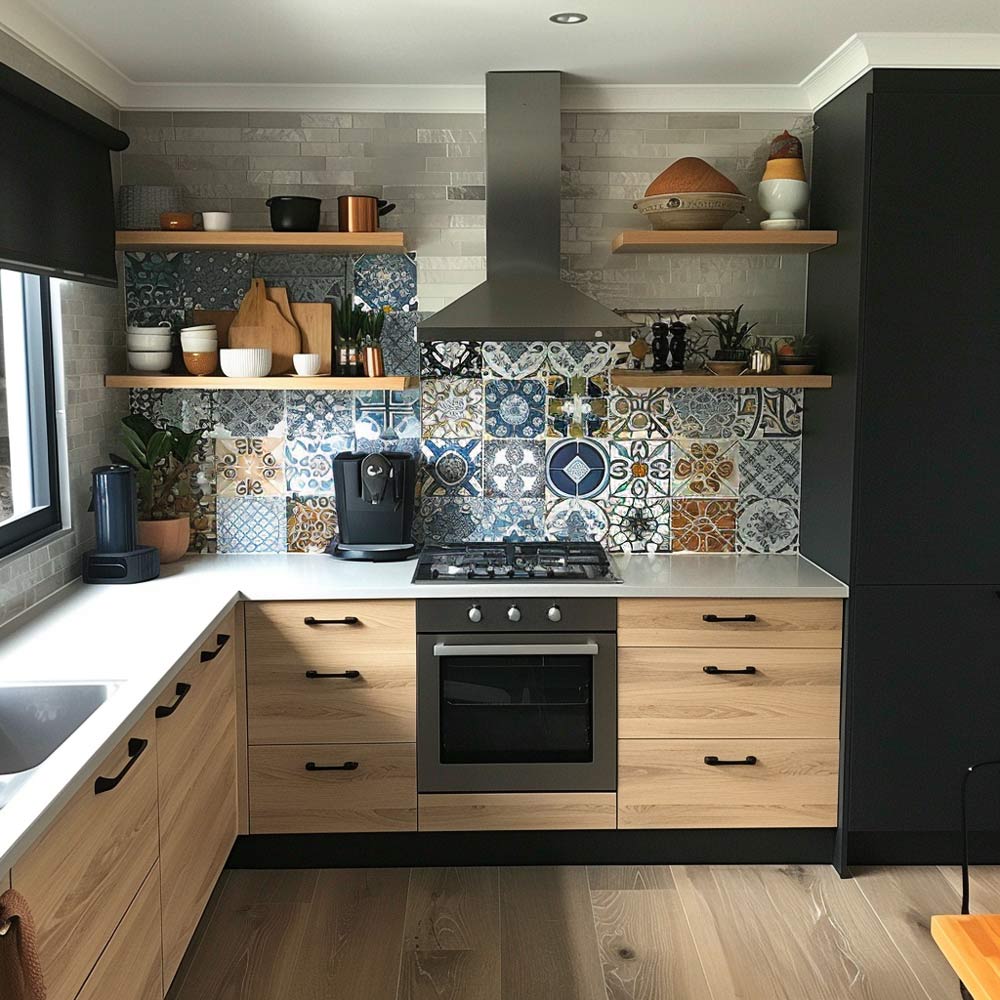

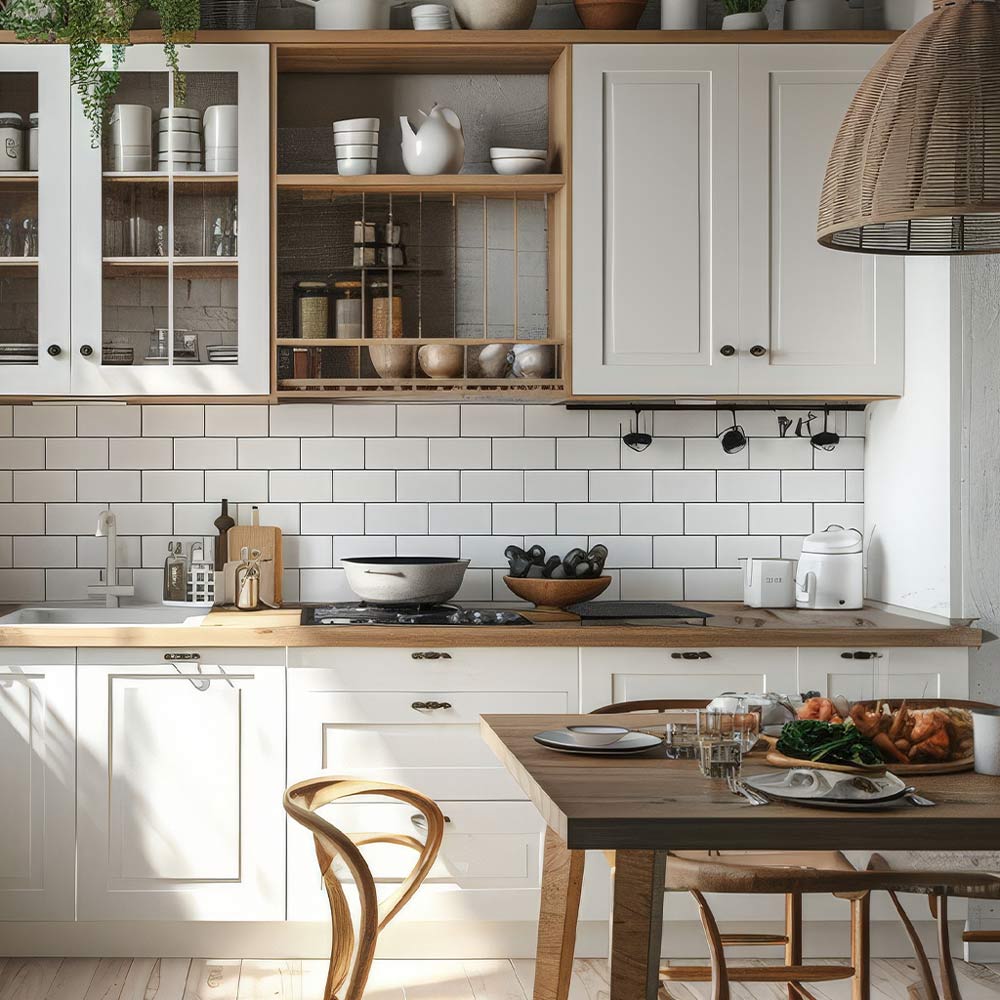

Glass Splashbacks
Benefits of Glass Splashbacks
Glass splashbacks are a popular choice for modern kitchens due to their sleek and stylish appearance. They are easy to wipe clean, resistant to stains, and reflect light, making your kitchen appear brighter and more spacious.
Different Styles of Glass Splashbacks
Glass splashbacks come in various styles, including plain, coloured, and printed designs. A plain glass splashback offers a minimalist look, while coloured glass can add a vibrant touch to your kitchen. Printed glass splashbacks allow for custom designs, such as images or patterns, to personalise your space.
Using Glass Splashbacks to Add Colour and Create a Focal Point
A coloured glass splashback can serve as a focal point in your kitchen, drawing attention and adding a splash of colour to your design. Whether you choose a bold hue or a subtle shade, a glass splashback can enhance your kitchen's overall colour scheme. At Cut My you can create the perfect coloured splashback to complement your decor with a glass custom colour splashback.
Acrylic Splashbacks
Introduction to Acrylic Splashbacks
Acrylic splashbacks have gained popularity in recent years due to their combination of style, affordability, and practicality. These splashbacks offer a sleek, modern look and come in a variety of colours and finishes, making them a versatile choice for any kitchen. Acrylic is a lightweight, durable material that can mimic the appearance of glass but at a fraction of the cost.
Benefits of Acrylic Splashbacks
Affordability: Acrylic splashbacks are cost-effective compared to glass or natural stone, making them ideal for budget-conscious DIY enthusiasts.
Ease of Installation: Lightweight and easy to handle, acrylic splashbacks can be installed with basic tools, saving time and money on professional installation.
Durability and Resistance: Acrylic is resistant to impacts and scratches, making it suitable for busy kitchens. It is also moisture and stain-resistant, ensuring long-lasting appeal.
Variety of Colours and Finishes: Available in a wide range of colours and finishes, acrylic splashbacks can be customised to match any kitchen design.
Reflective Properties: Like glass, acrylic splashbacks can reflect light, making the kitchen appear brighter and more spacious.
Installation Tips for Acrylic Splashbacks
Measuring and Cutting: Accurate measurements are crucial. Acrylic sheets can be easily cut with a fine-tooth saw or utility knife for precise fitting around fixtures.
Surface Preparation: Ensure the wall surface is clean, dry, and free from dust or grease for proper adhesive bonding.
Adhesive Application: Use high-quality adhesive designed for acrylic. Apply evenly and press the sheet firmly against the wall.
Sealing Edges: Seal edges with silicone sealant to prevent moisture damage and maintain the splashback's integrity.
Maintenance and Care for Acrylic Splashbacks
Cleaning: Use mild soap and water or a non-abrasive cleaner. Avoid harsh chemicals and abrasive sponges to prevent scratches.
Protecting from Heat: Acrylic is not as heat-resistant as glass or stainless steel. Use heat shields or install a heat-resistant panel behind the hob to protect the splashback.
Long-Term Care: Regularly inspect for scratches or damage. Buff out small scratches with plastic polish to restore shine.
Stainless Steel Splashbacks
Benefits of Stainless Steel
Stainless steel splashbacks are heat-resistant, easy to clean, and highly durable. They are an excellent choice for a busy kitchen, especially around the cooker and hob where spills and splashes are common.
Creating a Modern, Industrial Look
Stainless steel is ideal for creating a modern, industrial look in your kitchen. Its sleek, reflective surface complements contemporary kitchen designs and adds a professional, chef-style touch to the cooking area.
Combining Stainless Steel with Other Materials
You can combine stainless steel with other materials, such as glass or tiles, to create a unique and personalised kitchen splashback. This combination can add depth and texture to your kitchen design.
Mirrored Splashbacks
Advantages of Mirrored Splashbacks
Mirrored splashbacks can create a sense of space and reflect light, making your kitchen appear larger and brighter. They are particularly useful in small kitchens where space is limited.
Using Mirrored Splashbacks in Small Kitchens
In a small kitchen, a mirrored splashback can make a significant difference. By reflecting the room and bouncing light around, it creates the illusion of a larger, more open space.
Tips for Incorporating Mirrored Splashbacks
When incorporating a mirrored splashback, ensure it is made from toughened glass to withstand heat and impact. Consider placing it behind the hob or sink area to maximise its reflective properties.
Exposed Brick
Adding a Rustic, Traditional Style
Exposed brick splashbacks add a rustic, traditional style to your kitchen. They bring warmth and character, making them ideal for period properties or country-style kitchens.
Maintenance and Protection of Exposed Brick
To maintain and protect exposed brick, seal it with a clear sealant to prevent stains and moisture damage. Regular cleaning with a gentle brush will keep the brick looking its best.
Combining Exposed Brick with Modern Elements
Combining exposed brick with modern elements, such as stainless steel appliances or glass splashbacks, can create a balanced and visually appealing kitchen design. This mix of old and new adds depth and interest to your kitchen.
Choosing the Right Splashback Material
Factors to Consider
When choosing kitchen splashback materials, consider durability, resistance to extreme temperatures, ease of cleaning, and compatibility with your existing kitchen design and colour scheme.
Durability and Resistance to Extreme Temperatures
Select materials that can withstand the heat from cooking areas and are resistant to stains and splashes. Porcelain tiles, stainless steel, and natural stones are all excellent choices for their durability and heat resistance.
Ease of Cleaning and Maintenance
Choose a splashback material that is easy to clean and maintain. Glass splashbacks and stainless steel are particularly easy to wipe clean, making them ideal for busy kitchens.
Compatibility with Existing Kitchen Design and Colour Scheme
Ensure your splashback complements your kitchen design and colour scheme. Whether you choose a contrasting colour or a material that blends seamlessly with your cabinetry and worktops, the right splashback will enhance your overall kitchen design.
Splashback Ideas for Different Kitchen Styles
Matching Splashback Styles with Various Kitchen Designs
Different splashback styles suit different kitchen designs. Consider the overall style of your kitchen when choosing a splashback to ensure it complements your space.
Traditional Style Kitchens
For traditional style kitchens, porcelain tiles, natural stones, and exposed brick are excellent choices. These materials add warmth and character, creating a timeless appeal.
Modern Kitchens
Modern kitchens benefit from sleek and stylish splashbacks, such as glass, stainless steel, and mirrored designs. These materials add a contemporary look and enhance the overall aesthetic of the kitchen.
Period Properties
In period properties, consider using materials that reflect the history and character of the home. Exposed brick, patterned tiles, and natural stones are ideal for maintaining the traditional charm of period kitchens.
Practical Considerations for Installing Splashbacks
Taking Exact Measurements
Accurate measurements are crucial for a successful splashback installation. Measure the width and height of the area to ensure your splashback fits perfectly. Consider any obstacles, such as electrical outlets or cabinetry, when taking measurements.
Ensuring Proper Installation Around the Cooking Area, Gas Hob, and Sink
When installing a splashback around the cooking area, gas hob, and sink, ensure it is heat-resistant and easy to clean. Use high-quality adhesive and grout to secure tiles or panels, and seal any gaps to prevent water damage.
Tips for DIY Installation and When to Seek Professional Help
If you're confident in your DIY skills, installing a splashback can be a rewarding project. However, if you're unsure about any aspect of the installation, seek professional help to ensure a perfect finish.
Creative Splashback Ideas to Make a Statement
Using Splashbacks to Create a Focal Point
A splashback can serve as a focal point in your kitchen, drawing attention and adding interest. Consider using bold colours, unique patterns, or eye-catching materials to make a statement.
Combining Different Materials and Colours
Combining different materials and colours can create a unique and personalised splashback. For example, pair a glass splashback with patterned tiles or mix stainless steel with natural stones for a layered look.
Incorporating Splashbacks that Match Your Worktops and Cabinetry
For a cohesive look, choose a splashback that matches or complements your worktops and cabinetry. This creates a seamless design that ties the entire kitchen together.
Maintenance and Care for Kitchen Splashbacks
Tips for Keeping Your Splashback Clean and Free from Stains
Regular cleaning is essential to keep your splashback looking its best. Use a mild detergent and a soft cloth to wipe down tiles, glass, or stainless steel. For tougher stains, use a non-abrasive cleaner to avoid damaging the surface.
Regular Maintenance for Different Splashback Materials
Different materials require different maintenance routines. Glass and stainless steel need regular wiping to maintain their shine, while natural stones may need periodic sealing to protect against stains and moisture.
Long-Term Care to Maintain the Appearance and Functionality
Long-term care is crucial for maintaining the appearance and functionality of your splashback. Regularly inspect for any signs of damage, such as cracks or loose tiles, and address any issues promptly to ensure your splashback lasts for years to come.
Conclusion
Choosing the right splashback for your kitchen involves considering various factors, from materials and styles to installation and maintenance. By exploring different splashback ideas, you can find the perfect splashback that not only protects your kitchen walls but also enhances your kitchen design. Whether you opt for a traditional tile splashback, a modern glass splashback, or a rustic exposed brick design, your kitchen will benefit from the added style and functionality.
By following these tips and exploring various kitchen splashback ideas, you can transform your kitchen into a stylish and functional space that reflects your personal taste and meets your practical needs. Whether you're renovating a period property or updating a modern kitchen, the right splashback can make all the difference.


